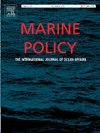Navigating the dual currents: Advanced insights into carbon emissions and economic growth in China's coastal marine fisheries
IF 3.7
2区 社会学
Q2 ENVIRONMENTAL STUDIES
引用次数: 0
Abstract
Decoupling carbon emissions from economic growth in marine fisheries is a crucial strategy for protecting marine ecosystems and promoting the sustainable development of fisheries. This research builds a comprehensive carbon emissions inventory for marine fisheries, accounting for both carbon sources and sinks, and examines the relationship between carbon emissions and economic growth in the marine fisheries sector across 11 coastal provinces of China. The study found that carbon emissions from marine fisheries in these provinces increased initially and then decreased between 2007 and 2022. Emissions displayed a low level of spatial clustering, exhibiting a relatively scattered distribution pattern. The decoupling of carbon emissions from economic growth in China's coastal marine fisheries is primarily characterized by weak decoupling (WD) and strong decoupling (SD). This decoupling is largely driven by factors such as energy intensity and industry size. Energy intensity and the size of the employed labor force exert a negative cumulative driving effect, while industrial scale has a positive cumulative driving effect. The government and relevant fishery departments should prioritize key fishery production areas, promote energy-saving upgrades for fishery facilities and fishing boat equipment, and vigorously develop low-carbon aquaculture to fulfill China’s “dual carbon” targets. The scientific research value of this paper enhances the analysis of the traditional decoupling index, constructing a relatively new analytical framework for exploring the relationship between the development of the marine fishery economy and the decoupling of carbon emissions.
驾驭双重潮流:对中国沿海海洋渔业碳排放和经济增长的先进见解
将海洋渔业的碳排放与经济增长脱钩是保护海洋生态系统和促进渔业可持续发展的重要战略。本研究构建了中国11个沿海省份海洋渔业碳排放综合清查表,考察了中国海洋渔业碳排放与经济增长的关系。研究发现,从2007年到2022年,这些省份的海洋渔业碳排放量先是增加,然后下降。排放空间集聚程度较低,呈相对分散的分布格局。中国沿海海洋渔业碳排放与经济增长的脱钩主要表现为弱脱钩(WD)和强脱钩(SD)。这种脱钩在很大程度上是由能源强度和行业规模等因素推动的。能源强度和就业劳动力规模具有负向的累积驱动效应,产业规模具有正向的累积驱动效应。政府和渔业相关部门要确定重点渔业产区,推进渔业设施和渔船设备节能升级,大力发展低碳养殖,实现中国“双碳”目标。本文的科研价值增强了对传统脱钩指标的分析,为探讨海洋渔业经济发展与碳排放脱钩的关系构建了一个比较新的分析框架。
本文章由计算机程序翻译,如有差异,请以英文原文为准。
求助全文
约1分钟内获得全文
求助全文
来源期刊

Marine Policy
Multiple-
CiteScore
7.60
自引率
13.20%
发文量
428
期刊介绍:
Marine Policy is the leading journal of ocean policy studies. It offers researchers, analysts and policy makers a unique combination of analyses in the principal social science disciplines relevant to the formulation of marine policy. Major articles are contributed by specialists in marine affairs, including marine economists and marine resource managers, political scientists, marine scientists, international lawyers, geographers and anthropologists. Drawing on their expertise and research, the journal covers: international, regional and national marine policies; institutional arrangements for the management and regulation of marine activities, including fisheries and shipping; conflict resolution; marine pollution and environment; conservation and use of marine resources. Regular features of Marine Policy include research reports, conference reports and reports on current developments to keep readers up-to-date with the latest developments and research in ocean affairs.
 求助内容:
求助内容: 应助结果提醒方式:
应助结果提醒方式:


